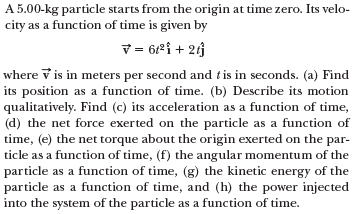A 5.00-kg particle starts from the origin at time zero. Its velo- city as a function of time is given by V = 62i + 23 where v is in meters per second and t is in seconds. (a) Find its position as a function of time. (b) Describe its motion qualitatively. Find (c) its acceleration as a function of time, (d) the net force exerted on the particle as a function of time, (e) the net torque about the origin exerted on the par- ticle as a function of time, (f) the angular momentum of the particle as a function of time, (g) the kinetic energy of the particle as a function of time, and (h) the power injected into the system of the particle as a function of time.
A 5.00-kg particle starts from the origin at time zero. Its velo- city as a function of time is given by V = 62i + 23 where v is in meters per second and t is in seconds. (a) Find its position as a function of time. (b) Describe its motion qualitatively. Find (c) its acceleration as a function of time, (d) the net force exerted on the particle as a function of time, (e) the net torque about the origin exerted on the par- ticle as a function of time, (f) the angular momentum of the particle as a function of time, (g) the kinetic energy of the particle as a function of time, and (h) the power injected into the system of the particle as a function of time.
College Physics
11th Edition
ISBN:9781305952300
Author:Raymond A. Serway, Chris Vuille
Publisher:Raymond A. Serway, Chris Vuille
Chapter1: Units, Trigonometry. And Vectors
Section: Chapter Questions
Problem 1CQ: Estimate the order of magnitude of the length, in meters, of each of the following; (a) a mouse, (b)...
Related questions
Question

Transcribed Image Text:A 5.00-kg particle starts from the origin at time zero. Its velo-
city as a function of time is given by
V = 62i + 23
where v is in meters per second and t is in seconds. (a) Find
its position as a function of time. (b) Describe its motion
qualitatively. Find (c) its acceleration as a function of time,
(d) the net force exerted on the particle as a function of
time, (e) the net torque about the origin exerted on the par-
ticle as a function of time, (f) the angular momentum of the
particle as a function of time, (g) the kinetic energy of the
particle as a function of time, and (h) the power injected
into the system of the particle as a function of time.
Expert Solution
This question has been solved!
Explore an expertly crafted, step-by-step solution for a thorough understanding of key concepts.
This is a popular solution!
Trending now
This is a popular solution!
Step by step
Solved in 6 steps with 4 images

Recommended textbooks for you

College Physics
Physics
ISBN:
9781305952300
Author:
Raymond A. Serway, Chris Vuille
Publisher:
Cengage Learning

University Physics (14th Edition)
Physics
ISBN:
9780133969290
Author:
Hugh D. Young, Roger A. Freedman
Publisher:
PEARSON

Introduction To Quantum Mechanics
Physics
ISBN:
9781107189638
Author:
Griffiths, David J., Schroeter, Darrell F.
Publisher:
Cambridge University Press

College Physics
Physics
ISBN:
9781305952300
Author:
Raymond A. Serway, Chris Vuille
Publisher:
Cengage Learning

University Physics (14th Edition)
Physics
ISBN:
9780133969290
Author:
Hugh D. Young, Roger A. Freedman
Publisher:
PEARSON

Introduction To Quantum Mechanics
Physics
ISBN:
9781107189638
Author:
Griffiths, David J., Schroeter, Darrell F.
Publisher:
Cambridge University Press

Physics for Scientists and Engineers
Physics
ISBN:
9781337553278
Author:
Raymond A. Serway, John W. Jewett
Publisher:
Cengage Learning

Lecture- Tutorials for Introductory Astronomy
Physics
ISBN:
9780321820464
Author:
Edward E. Prather, Tim P. Slater, Jeff P. Adams, Gina Brissenden
Publisher:
Addison-Wesley

College Physics: A Strategic Approach (4th Editio…
Physics
ISBN:
9780134609034
Author:
Randall D. Knight (Professor Emeritus), Brian Jones, Stuart Field
Publisher:
PEARSON